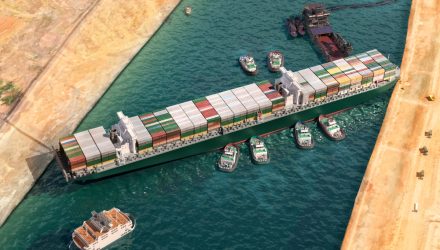ETF Trends CEO Tom Lydon discussed the Breakwave Dry Bulk Shipping ETF (BDRY) on this week’s “ETF of the Week” podcast with Chuck Jaffe on the MoneyLife Show.
BDRY provides long exposure to the dry bulk shipping market through a portfolio of near-dated freight futures contracts on dry bulk indices. It’s the first and only freight futures exchange-traded product exclusively focusing on dry bulk shipping. The fund is a pure-play exposure to dry bulk shipping, an instrumental part of the global commodity market, uncorrelated to other major assets. It’s designed to profit from increases in freight futures beyond what is already priced in the market.
The Suez Canal debacle has highlighted the importance of global maritime trade and a way for investors to access this market. BDRY jumped 10% on the day the Suez Canal blockage was announced. Even before the canal logjam, BDRY gained +150% year-to-date on the improving global economic outlook as economies reopened and trade resumed.
What Happened With The Suez Canal?
A 400-meter (430-yard) long Ever Given container ship blocked all traffic on one of the world’s busiest shipping arteries. The 120-mile Suez Canal connects the Red Sea to the Mediterranean and is a key route for oil and gas tankers. Around one-tenth of the all-seaborne oil trade around the world goes through the canal.
The Suez Canal is obviously a very significant part of the global shipping market, as it reduces the distance that ships have to travel between Asia and Europe/N America. With a ship stuck in the canal, any container ships would have to go around the southern tip of Africa. Re-routing ships around the Cape of Good Hope off South Africa’s coast could add around two more weeks to a voyage. Doing so would add more than 800 tonnes of fuel consumption for Suezmax tankers — the largest-sized ships which can travel through the Suez Canal.
Fuel is a ship’s single biggest cost, representing up to 60 percent of operating expenses. The blockage added another setback for the global supply chain, which has already been strained by the coronavirus pandemic. The closure of the Suez Canal caused a major issue in the logistics of shipping, causing ships to divert, wait longer, or get stuck. Any problems with the Suez Canal are positive for shipping rates since disruptions in shipping tend to push shipping rates higher.
Fundamentals for dry shipping were already favorable. The Suez Canal incident was just icing on the cake. Shipping rates for oil product tankers have nearly doubled after the ship ran aground in the vital trade waterway. The suspension of traffic through the narrow channel linking Europe and Asia has deepened problems for shipping lines that were already facing disruption and delays in supplying retail goods to consumers.
As noted, BDRY is designed to profit from increases in freight futures beyond what is already priced in the market. The fund is designed to reduce the effects of rolling futures contracts by using a laddered strategy to buy contracts while letting existing positions expire and settle in cash.
Listen to the full podcast episode on the BDRY:
For more podcast episodes featuring Tom Lydon, visit our podcasts category.

